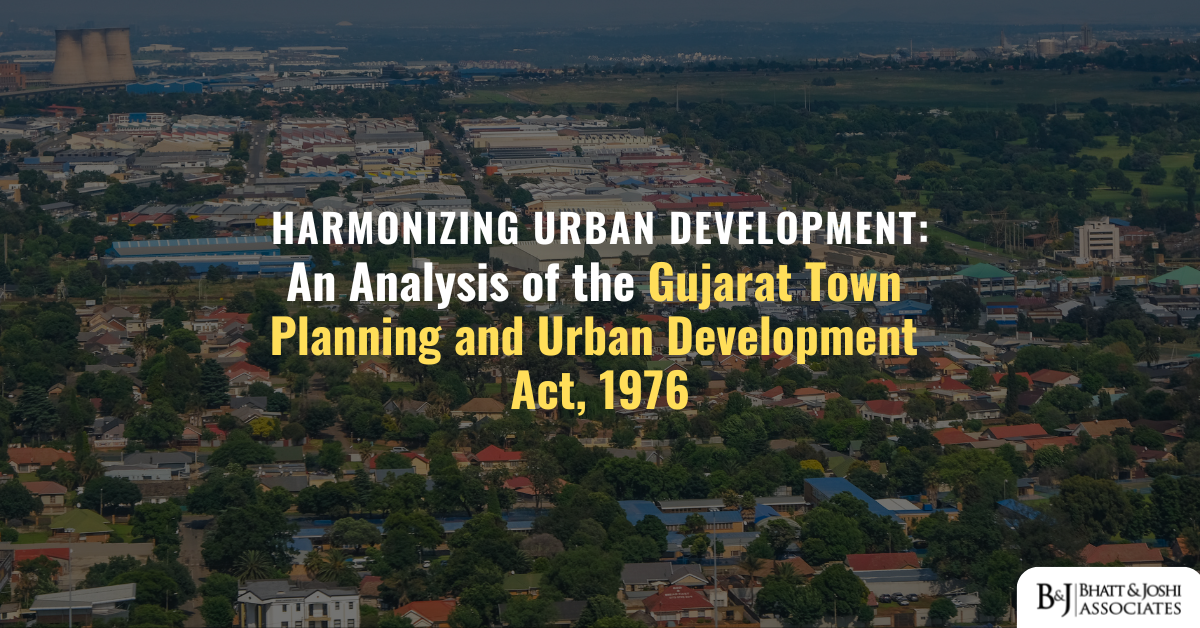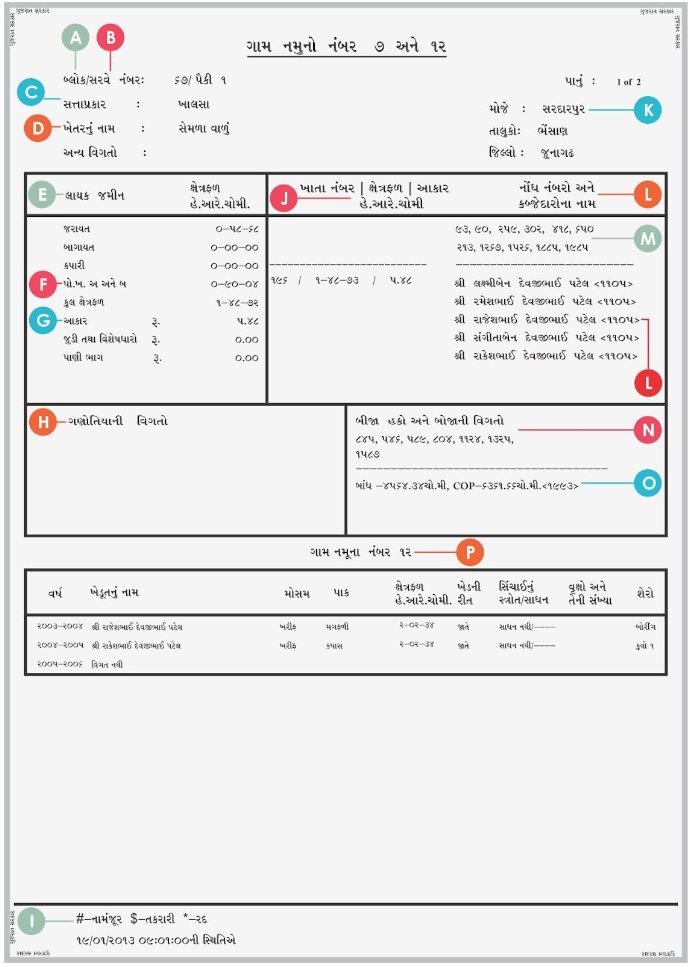Introduction
Gujarat’s approach to urban planning represents one of India’s most sophisticated frameworks, integrating long-term vision with practical implementation mechanisms. At its core is the Gujarat Town Planning and Urban Development Act, 1976 (GTPUDA), which creates a three-tiered system comprising Development Plans, Gujarat’s town planning Schemes, and General Development Control Regulations. This article provides a comprehensive analysis of how these components function in synergy, supported by evolving jurisprudence that ensures coherent implementation.
Understanding the Legislative of Gujarat’s Town Planning Framework
The Genesis and Purpose of GTPUDA
The GTPUDA emerged from the need to systematize urban growth in Gujarat’s rapidly expanding cities. Its primary objective is to ensure planned development through a framework that balances public infrastructure needs with private property rights. Prior to this Act, urban development was often haphazard, with inadequate infrastructure and insufficient public spaces.
The Act establishes Urban Development Authorities (UDAs) and Area Development Authorities (ADAs) under Section 5 and Section 6 respectively, empowering them to prepare and implement development plans. These authorities serve as the institutional backbone for urban planning in Gujarat.
Three Pillars of Gujarat’s Town Planning
- Development Plan (DP): The macro-level blueprint providing a 20-25 year vision for land use, zoning, and infrastructure development.
- Town Planning Scheme (TPS): The micro-level implementation mechanism that reconstitutes land parcels to create infrastructure while ensuring equitable distribution of development benefits.
- General Development Control Regulations (GDCR): Technical rules governing construction parameters, land use compatibility, and building standards.
This three-tiered approach creates a comprehensive planning framework that operates at different scales but maintains internal consistency.
Development Plan: The Master Blueprint
Legal Definition and Statutory Basis
According to Section 2(10) of GTPUDA, a Development Plan means “a plan for the development or redevelopment of the area within the jurisdiction of an Authority.” The preparation process is outlined in Sections 9-19 of the Act.
Preparation Process and Contents
The preparation follows a structured process:
- Declaration of Intention (Section 9): The Authority publishes its intention to prepare a Development Plan.
- Draft Development Plan (Section 10): Within 3 years, a draft plan is prepared containing:
- Proposed land uses (residential, commercial, industrial, recreational)
- Road networks and transportation systems
- Reservations for public purposes (schools, hospitals, parks)
- Zoning regulations and development control
- Public Participation (Section 13-15): The draft is published for objections and suggestions from citizens, fostering participatory planning.
- Consideration of Objections (Section 16): A committee addresses public input before finalizing the plan.
- State Government Sanction (Section 17): The final Development Plan becomes legally binding after state approval.
- Revision (Section 18-19): Periodic revisions ensure relevance to changing urban needs.
Judicial Interpretations on Development Plans
In Ahmedabad Municipal Corporation v. Ahmedabad Green Belt Khedut Mandal (2014), the Supreme Court held that Development Plans must respect constitutional rights to property while serving public interest. The court emphasized that arbitrary zone changes without technical justification are impermissible.
Similarly, in Reliance Industries Ltd. v. State of Gujarat & Ors. (2017), the Gujarat High Court ruled that Development Plans cannot be modified capriciously and must follow the same rigorous process as their original formulation.
Town Planning Scheme: The Implementation Mechanism
Definition and Purpose
Section 2(25) defines a Town Planning Scheme as “a scheme whereby the pattern of an area is improved by the development of land and by the construction, alteration, or removal of buildings thereon.”
TPS operates through the principle of land pooling and reconstitution, where irregular land parcels are pooled, infrastructure is planned, and final plots are returned to owners proportionate to their original holdings.
Stages of Town Planning Scheme
| Stage | Legal Provision | Key Actions | Timeframe | Authority |
|---|---|---|---|---|
| Declaration of Intention | Section 40 | Publication of intent to prepare TPS | Initial step | Local Authority |
| Draft Scheme | Section 41-47 | Preparation and publication of draft scheme | Within 12 months of declaration | Local Authority |
| Objection Period | Section 48 | Inviting and addressing public objections | 1 month from publication | Local Authority |
| Sanction of Draft Scheme | Section 48(2) | State Government approves draft scheme | After addressing objections | State Government |
| Appointment of TPO | Section 50 | Appointment of Town Planning Officer | After sanction of draft scheme | State Government |
| Preliminary Scheme | Section 52 | TPO prepares preliminary scheme after hearings | Within 12 months of appointment | Town Planning Officer |
| Final Scheme | Section 65 | Final scheme prepared and submitted | After addressing appeals | State Government |
| Implementation | Section 66-67 | Execution of scheme provisions | After final sanction | Local Authority |
Key Features of Town Planning Schemes
- Land Reconstitution (Section 45): Original plots are reconstituted into final plots after deducting land for:
- Roads and infrastructure (typically 20-30%)
- Social amenities like parks, schools (15-20%)
- Sale to fund the scheme (5-10%)
- Incremental Contribution (Section 67): Landowners contribute proportionately to infrastructure costs based on the increase in land value.
- Compensation Mechanism (Section 67): Landowners receive compensation for:
- Difference between original and final plot values
- Structures demolished during implementation
- Temporary displacement costs
Judicial Precedents on Town Planning Schemes
In Mrugendra Indravadan Mehta v. Ahmedabad Municipal Corporation (2024), the Supreme Court reaffirmed that Town Planning Schemes must be interpreted as a complete code, ensuring that variations under Sections 70 and 71 must be harmonized to maintain procedural consistency.
The Gujarat High Court in Sultanbhai Jamalbhai Mansuri vs. State of Gujarat (2022) emphasized that objections filed under Rule 26(3) must be considered by the Town Planning Officer before the scheme’s sanctioning.
Notably, in Manekbai Kanji v. New Ahmedabad Manufacturing Co. Ltd. (1972), the court established that TPS provisions override private agreements concerning land use once the scheme is sanctioned.
General Development Control Regulations: Technical Framework
Legal Basis and Purpose
The GDCR derives its authority from Section 116A of GTPUDA, which empowers the State Government to frame regulations for controlling development. The current Gujarat GDCR 2017 provides comprehensive technical parameters for construction and land use.
Key Provisions of GDCR 2017
- Floor Space Index (FSI) Regulations:
- Rule 7.1 specifically addresses FSI calculation for plots divided by roads: “When a plot is affected by road line/road widening or reservation, FSI shall be permissible on the original plot area. The owner shall handover the affected area to the appropriate authority free of cost in lieu of FSI on said affected area.”
- This means that even if a road divides an original plot into multiple final plots, the FSI is calculated based on the entire original plot area.
- Unified Treatment of Divided Plots:
- Rule 4.3 mandates that: “If a plot is divided into two or more parts due to road planning or any infrastructure, all divided parts shall be treated as one plot for development purposes including FSI calculation.”
- This ensures landowners aren’t penalized through reduced development rights when roads are introduced through their plots.
- Zoning Compliance:
- Rule 12.1-12.5 stipulates that all construction must comply with the zone designated in the Development Plan.
- Different permissible uses (residential, commercial, industrial) have specific development controls.
Case Study: Rajkot Final Plot No. 236
In the landmark case concerning Rajkot Final Plot No. 236 (Kantilal Manilal Patel v. Rajkot Municipal Corporation, 2019), the Gujarat High Court addressed the issue of a road dividing an original plot:
- The petitioner owned a large plot that was divided by a proposed 12-meter road.
- The TPO had allocated two separate final plots (236/1 and 236/2) on either side of the road.
- The petitioner challenged this division, arguing that it reduced development potential.
- The Court ruled that:
- Under GDCR Rule 7.1, FSI must be calculated on the entire original plot area.
- The landowner should be permitted to utilize the combined FSI across both final plots.
- The authority must consider both plots as a single entity for development permission purposes.
This judgment reinforced the principle that GDCR provisions must be interpreted to maximize development rights when infrastructure necessitates plot division.
Synergy Between Development Plan, TPS, and GDCR
Hierarchical Relationship
The three components operate in a hierarchical relationship:
- Development Plan: Establishes the macro-level vision and zoning.
- Town Planning Scheme: Implements the DP vision through land reconstitution.
- GDCR: Provides technical parameters for actual construction.
This relationship is legally enforced through Section 40(3) of GTPUDA, which mandates that Town Planning Schemes must conform to the Development Plan. Similarly, Rule 3.1 of GDCR stipulates that all development permissions must comply with both the Development Plan and applicable Town Planning Schemes.
Practical Implementation Harmony
When functioning properly, these three components work in tandem:
- The Development Plan designates a commercial corridor along a major road.
- The Town Planning Scheme reconstitutes irregular agricultural plots into regularly shaped commercial plots with proper road access.
- The GDCR determines permissible height, FSI, and setbacks for commercial buildings on these plots.
Resolving Conflicts Between Components
Courts have established clear principles for resolving conflicts:
- Primacy of Development Plan: In Babubhai & Co. v. State of Gujarat (2016), the High Court ruled that TPS provisions cannot override DP reservations.
- Self-Contained Code: The Supreme Court in Jayesh Dhanesh Goragandhi v. Municipal Corporation of Greater Mumbai (2012) established that TP Schemes function as a “self-contained code,” overriding conflicting provisions in other legislation.
- Equitable Interpretation: In Ahmedabad Urban Development Authority v. Sharadkumar Jayantilal Panchal (2016), the court mandated that GDCR provisions must be interpreted to maximize utility while maintaining public purpose.
Comprehensive Judicial Framework
Principle of Harmonious Construction
Courts have consistently held that GTPUDA’s provisions must be read holistically:
- No Provision in Isolation: In Reliance Industries Ltd. v. Gujarat Industrial Development Corporation (2013), the Supreme Court emphasized that no provision of GTPUDA can be read in isolation from other provisions.
- Scheme as a Whole: The Gujarat High Court in Piyush N. Patel v. State of Gujarat (2018) ruled that objections to TPS must be considered in light of the scheme’s overall objectives, not merely technical compliance.
- Purpose-Oriented Interpretation: In Ahmedabad Municipal Corporation v. Hathising Manufacturing Co. (2011), the court mandated that technical defects in procedure do not invalidate a scheme if its substantive purpose is achieved.
Landmark Judgments Shaping Gujarat’s Town Planning Jurisprudence
- Balance Between Public and Private Interests:
- Jamnadas Prabhudas v. State of Gujarat (1976): Established that land reconstitution must balance infrastructure needs with private property rights.
- Narandas Karsandas v. S.A. Kamdar (1977): Recognized that temporary diminution of property rights is permissible for long-term planning benefits.
- Procedural Safeguards:
- Sulochana Ben v. State of Gujarat (2014): Held that failure to consider objections renders a scheme legally flawed.
- Chirag Construction v. Ahmedabad Municipal Corporation (2017): Established timeline requirements for processing objections.
- Integration of Planning Components:
- Builders Association of India v. State of Gujarat (2013): Ruled that GDCR amendments must align with Development Plan objectives.
- Ahmedabad Study Action Group v. State of Gujarat (1997): Emphasized the need for environmental considerations in all planning components.
Practical Implications for Stakeholders
For Landowners and Developers
- Rights Under the Act:
- Right to object to Draft DP/TPS under Sections 15 and 47
- Right to proportionate reconstitution under Section 45
- Right to compensation for acquired land under Section 67
- Strategic Considerations:
- Monitor gazette notifications for planning intentions
- Submit timely, well-reasoned objections
- Understand GDCR provisions to maximize development potential
- Seek unified treatment of plots divided by infrastructure
- Common Issues and Remedies:
- For excessive deductions, cite Section 45 proportionality principles
- For divided plots, invoke GDCR Rule 7.1 for unified FSI calculation
- For delayed implementation, seek remedies under Section 69
For Planning Authorities
- Statutory Obligations:
- Ensure Development Plan-TPS-GDCR consistency
- Consider all objections under Sections 16 and 47
- Follow prescribed timelines for plan preparation
- Best Practices:
- Conduct thorough surveys before plan preparation
- Ensure transparent public participation
- Provide detailed reasoning for accepting/rejecting objections
- Maintain proper records of all planning decisions
Conclusion: The Future of Gujarat’s Town Planning Framework
Gujarat’s town planning framework represents a sophisticated system that balances macro-vision with micro-implementation. The synergy between Development Plans, Town Planning Schemes, and GDCR has made Gujarat a model for urban development in India.
Recent judicial interventions have further strengthened this framework by emphasizing several key principles:
- No provision of the Act can operate in isolation.
- Planning instruments must be interpreted to maximize both public benefit and private development rights.
- Procedural safeguards must be respected to ensure equitable outcomes.
The success of Gujarat’s town planning framework has been evident in cities like Ahmedabad, where TPS mechanisms have created well-planned areas with adequate infrastructure. However, challenges remain, particularly in implementation timelines and addressing emerging urban issues like climate resilience and affordable housing.
Future reforms should focus on:
- Streamlining approval processes
- Incorporating digital technologies for planning and monitoring
- Enhancing climate-responsive planning provisions
- Strengthening mechanisms for inclusionary development
The enduring principle that provisions of town planning law cannot operate in isolation but must function harmoniously continues to guide both legislative amendments and judicial interpretations, ensuring that Gujarat’s urban areas develop in a planned, equitable, and sustainable manner.












